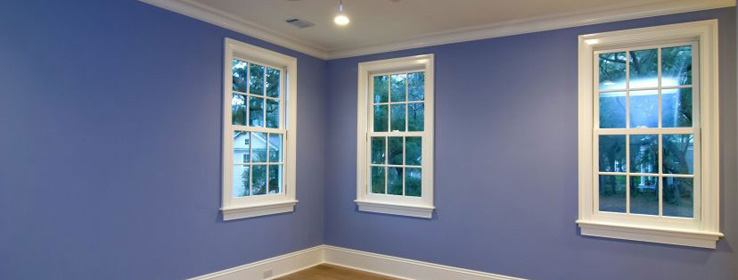While often overlooked, trim can have a dramatic effect on the way a room is perceived.
Interior trim can give a room balance, definition and proportion; highlight points of architectural interest and ornamentation; and set its tone and character. It can take the form of window and door casings; baseboards; wainscoting and paneling; pillars and mantels; and crown, picture and chair-rail molding. Think of trim like the frame of a painting: It outlines and enhances the beauty of what's inside.
At its most elemental, trim adds punctuation to a room's elements. Crown molding signals that the wall is ending and the ceiling is beginning. Baseboard announces the transitions between wall and floor. Casings define the perimeter of doors and windows.
But trim also has the aesthetic function of enhancing or changing the perception of a room's size and shape. By using trim to create strong lines, you can make a room seem larger, or by breaking up soaring walls, you can make it seem cozier. Through the use of trim you can both enhance and complete the design style you envision for the space.
Both the architectural style of the home and your client's personal taste will play a large part in both the style and color options for trim. For example, heavy Victorian trim does not suit a ranch-style structure or an Arts and Crafts cottage, just as minimalist trim lacks the impact required for a Victorian or Georgian design.
As with any design decision, when selecting the trim types and colors for a room, you have to determine the end goal. What impression does your client want the room to convey? Relaxed or stimulating? Modern or classical? Sophisticated or eclectic? Dramatic or formal?
Trim types
Most trim is constructed from wood, medium density fiberboard (MDF) or polyurethane.
Wood. Most interior trim projects are done with stock softwood moldings. Pine, poplar and basswood are all common species. Stain-grade moldings are made from single lengths of lumber without knots. Paint-grade moldings may have cosmetic flaws or be made up of many shorter pieces that are butt- or finger-jointed together. For clear-finished trim work, it's best to use specialty hardwoods like oak, cherry and maple.
MDF. This paint-grade trim is less expensive than wood but when painted is difficult to distinguish from the real thing. MDF trim has a smooth surface, comes pre-primed, can usually be finished with one coat of paint, requires little or no sanding, and is more resistant to dings and dents than most softwoods. However, it's heavy, requires more labor to install and will reflect every undulation in an uneven wall.
High-density polyurethane. This is a lightweight, inexpensive alternative to wood. It comes in many patterns (including ornate classical profiles that are extremely expensive to duplicate in wood), is easy to install, and requires no priming or sanding before painting. It won't rot, and it expands and contracts much less than wood when exposed to severe changes in temperature and humidity.
Going with the same color
For a contemporary room, design experts suggest using techniques that help the trim blend with the room color. This can be achieved by painting the trim the same color as the walls or a tinted version of it. It gives the room a fresh, unified look. If the walls are warm-toned, it's usually a good idea to stick with a warm trim. Likewise, pair cool wall tones with cool trim tones. Sticking with the same undertones keeps a room from looking disjointed and the colors from looking muddy. For open floor layouts, where rooms flow into each other or are adjoined by open entryways, keeping trim style and color consistent throughout provides a sense of cohesiveness, especially if the wall color changes from room to room.
Going lighter
For classic or traditional interiors, using a white or off-white paint can really play up the trim and bring out its historical or intricate qualities. And many design experts consider white the perfect color for any trim, regardless of interior style or wall color. With dark walls, white trim lightens and brightens the room while making the wall color really "pop." And when walls are painted light or muted colors, white trim makes the color appear crisp and clean. Pure white, which is often thought of as cool or blue white, is ideal in a room with great natural light. It pairs well with cool-toned walls, has the most reflective quality, and is ideal for southern climates and ocean views. In northern climates, or in rooms with limited natural light, pure white may look too gray. For these conditions, use creamy whites with warm (yellow) undertones.
Going dark
A trend that has grown in popularity of late is selecting dark colors for trim – even black. Dark trim gives a room more depth than white or light trim does, and very effectively frames views when used on window casings. In addition, dark trim contrasts nicely with some of today's trendiest room colors: soft aquas, powder blues, greens – from lime to celadon – and the gamut of grays. And going dark doesn't have to mean just dark brown or black – consider selecting a color that's several shades deeper than the color you've chosen for the walls. And of course, homes built in the late 19th century and earlier normally included beautifully intricate woodwork stained or varnished in colors ranging from mahogany to honey.
Tricks of the trade
Just as wall color can affect the size, shape and appearance of a room and even alter the mood, so too can the use of trim.
Lower the ceiling. Install picture-rail or chair-rail molding on the walls of the room and paint the rail, and/or the wall area above it, a darker color than the rest of the walls to draw the ceiling down.
Raise the roof. Install crown molding around the perimeter of the ceiling and paint it a darker color than the ceiling to draw the eye upwards. Another technique is to take the door trim right up to the ceiling, creating what is called "entablature." This appears to make the ceiling rise.
Enlarge a room. Paint the trim the same color as or a lighter shade than the wall color to make the walls feel like they are receding.
Shorten a room. To make a long room appear shorter, install wood panels on the end wall.
Highlight an architectural feature. Paint the feature – be it an archway, pillar or mantel – a color that contrasts with but is of equal intensity to the walls, to guide the eye to the feature.
Lighten it up. To keep dark walls from looking oppressive, consider adding a chair rail or wainscoting to the lower half.
Achieve Old World style. If you want a room to reflect a colonial-style design, try pairing off-white or cream walls with contrasting trim – for example, gray-blue, muted green, mustard yellow or barn red.
Leave it natural. For rooms with high-quality wood trim, leaving the trim and doors a natural color plays up the beautiful texture of the wood and brings natural warmth and texture to the room.
For more information:
Decorating With Interior Trim by Lisa Stockwell Kessler. (Sunset Books, 2003)
The New Decorating with Architectural Trimwork by Jay Silber. (Creative Homeowner, 2nd edition, 2005)
Trim Idea Book by Mary Ellen Polson. (Taunton, 2005)
Creating a New Old House: Yesterday's Character for Today's Home by American Institute of Architects. (Taunton, 2007)










